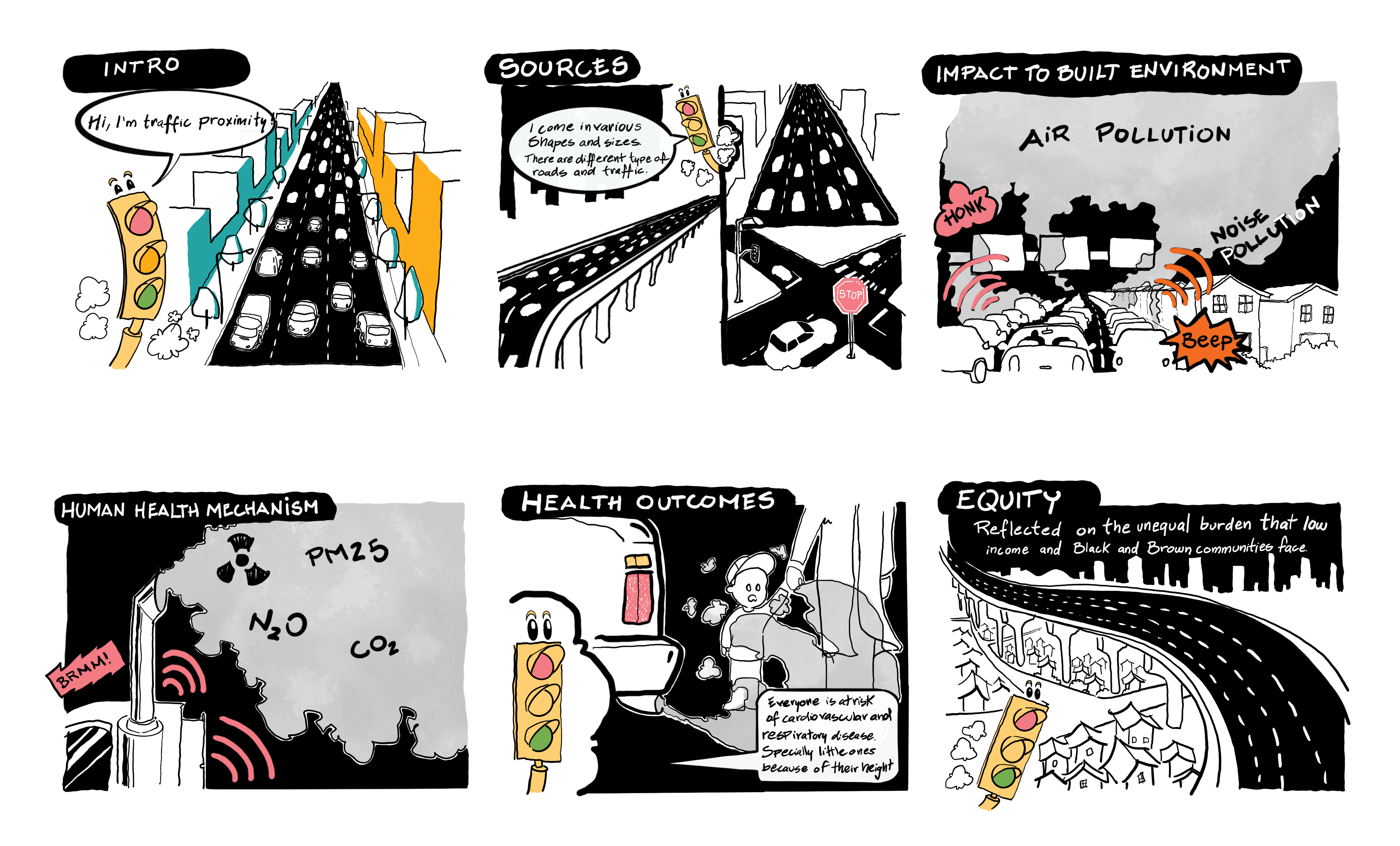
Click here for caption
Transcript: Hi, I’m traffic proximity! While roads help us get connected to our surroundings, there are negative aspects of being close to high volumes of traffic. There are several different types of roads and traffic – from highways, major arterial roads to small residential ones, I come in various shapes and sizes. Vehicles are one of the main ways that we move through our environment. They also cause a lot of pollution to our environment, particularly air and noise. Vehicular traffic emits harmful pollutants, such as PM2.5, carbon monoxide and nitrous dioxide, which are harmful to our respiratory system. Major roadways are also very noisy, leading to a higher risk for cardiovascular disease. Traffic can also cause respiratory and cardiovascular problems down the road. (no pun intended!) Traffic proximity similarly reflects the unequal burden that low-income and Black and Brown communities face in our built environments. Highways and major roads were often placed in these communities with little support to deal with their harm. Designers must be cognizant of these historical and ongoing inequities.
Definition
Proximity to traffic provides information on the distance of major roadways and the density of traffic on those roads. Traffic proximity is based on the traffic within a 500 meter search radius; this distance is large enough to capture the great majority of roadways that could have significant impacts on local residents. While proximity to roads provides access to jobs, health care, food, recreational opportunities, and other benefits, this indicator is designed to screen for the negative aspects of close proximity to high volumes of traffic, which include asthma, respiratory disease, cardiovascular disease, and delays in child development. According to the Center for Disease Control and Prevention (CDC), more than 11 million people in the U.S. live within 150 meters from a major highway.
Human Health Mechanism
Proximity to traffic affects the amount of noise and air pollution individuals experience. Exposure to traffic noise can also lead to increased stress and sleep disturbances. Additionally, vehicular traffic emits harmful pollutants, such as PM2.5, carbon monoxide and nitrous dioxide, which are harmful to our respiratory system. People who live close to major roads, streets, or highways are exposed to a higher amount of these air pollutants compared to those who do not live in such areas. As a result, nearby individuals suffer from a heightened risk of respiratory and cardiovascular diseases, such as asthma and coronary heart disease.
Indicator Measurement
Data on traffic proximity are provided by the US Environmental Protection Agency’s (US EPA) EJScreen, an environmental justice screening tool that uses national data to map places that are more vulnerable and susceptible to environmental burdens. EJScreen calculates traffic proximity by count of vehicles (annual average daily traffic [AADT]) at major roads within 500 meters, divided by distance in meters. EJScreen’s traffic proximity metric is a weighted value, meaning that closer traffic is given more weight and more distant traffic is given less. For example, traffic 500 meters away is given only one tenth as much weight as traffic 50 meters away.
Source of Exposures
There are many different types of roads and sources of traffic, ranging from major highways to residential streets. Zoning regulations and urban planning permissions may also impact the establishment of roadways and nearby businesses. The positioning of highways is inherently tied to racial discrimination, as they have been predominantly constructed through communities of color. Consequently, this has led to an unequal distribution of highway pollution, disproportionately affecting these communities.
Related Health Outcomes & Exposures
PM2.5, Ozone, Respiratory Health, Cardiovascular Health, Noise Pollution
References
Click here for References
- Traffic Proximity Data Source: US EPA. EJScreen: Traffic Proximity and Volume. Data year 2020. Retrieved April 2023 from https://www.epa.gov/ejscreen/download-ejscreen-data
- Brender JD, Maantay JA, Chakraborty J. Residential proximity to environmental hazards and adverse health outcomes. Am J Public Health. 2011;101 Suppl 1(Suppl 1):S37-S52. doi:10.2105/AJPH.2011.300183
- Eitland E, Klingensmith L, MacNaughton P, et al. Schools For Health. 2017. Accessed October 19, 2023. https://forhealth.org/Harvard.Schools_For_Health.Foundations_for_Student_Success.pdf.
- Kweon B.-S., Mohai P., Lee S., Sametshaw A.M. Proximity of public schools to major highways and industrial facilities, and students’ school performance and health hazards. Environ. Plan B Urban Anal. City Sci. 2018;45:312–329. doi:10.1177/0265813516673060.
- Perkins&Will. Healthy Schools by Design. Published April 18, 2023. Accessed October 19, 2023. https://issuu.com/perkinswill/docs/hsbd_2023_ee
- US EPA. EJScreen Map Descriptions. Published June 3, 2015. Accessed October 15, 2023. https://www.epa.gov/ejscreen/ejscreen-map-descriptions
- US EPA. EJScreen Technical Documentation for Version 2.2. Updated July 2023. Accessed November 21, 2023. https://www.epa.gov/ejscreen/technical-information-about-ejscreen#:~:text=EJScreen%20Technical%20Documentation%20(pdf)
- Xiao W. The Road to Racial Justice: Resolving the Disproportionate Health Burden Placed on Communities of Color by Highway Pollution. Columbia Human Rights Law Review. 2021; 52(2):911-956. Accessed October 15, 2023. https://hrlr.law.columbia.edu/hrlr/the-road-to-racial-justice-resolving-the-disproportionate-health-burden-placed-on-communities-of-color-by-highway-pollution/
